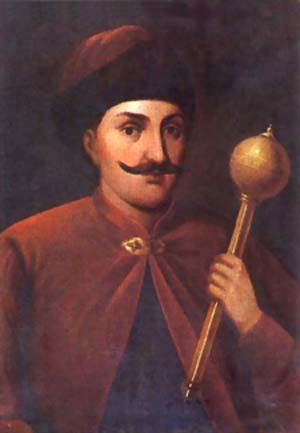|
|||
|
Philatelia.Net / Fragments of Russian History / Plots / The directory ЂPlotsїVyhovsky (¬иговський) Ivan Efstafievich (?Ч1664)Ivan Vyhovsky was a hetman of the Ukrainian Cossacks during three years (1657-1659) of the Russo-Polish War (1654Ц1667). He was the successor to the famous hetman and rebel leader Bohdan Khmelnytsky. His time as hetman was characterized by his generally pro-Polish policies, which led to his defeat by pro-Russian Cossacks. Vyhovsky, son of Ostap Vyhovsky (vicegerent of Kyiv fortress under voivode Adam Kisiel), was an Orthodox nobleman from the Kyiv region. He studied at the prestigious Orthodox Kyiv-Mohyla Academy. In Polish military service, he was captured by Khmelnystsky's rebel Cossack forces at Zhovti Vody in May of 1648, he was freed on account of his education and experience and rose to become secretary-general or chancellor (heneralny pysar) of the Cossacks and one of Khmelnytsky's closest advisors. Elected hetman upon the death of Khmelnytsky, Vyhovsky sought to find a counterbalance to the pervasive Russian influence present in Ukraine after the 1654 Treaty of Pereyaslav. While the Cossack elite and the ecclesiastical authorities supported this pro-Polish orientation, the masses and the Cossack rank-and-file remained deeply suspicious and resentful of the Poles, by whom they had long been forced into serfdom. As a result, some Cossacks, led by Iakiv Barabash, put forward an alternative candidate for the hetmancy in Martyn Pushkar, the colonel of the Poltava regiment]] of Cossacks. The rebellion against the hetman grew, and came to a head when Vyhovsky's forces clashed with the pro-Russian Cossacks in June of 1658. Vyhovsky's forces prevailed, killing Pushkar and forcing Barabash to flee (he would later be captured and executed). However, it had clearly been a fratricidal conflict, resulting in some 50,000 deaths. Following his consolidation of power within Ukraine, Vyhovsky attempted to reach an acceptable agreement with the Poles. Encouraged by his aristocratic friend Iurii Nemyrych, Vyhovsky entered negotiations with the Polish government, which resulted in the Treaty of Hadiach. Under the conditions of the treaty, Ukraine would become a third and autonomous component of the Polish-Lithuanian Commonwealth, under the ultimate sovereignty of the King of Poland, but with its own military, courts, and treasury. Additionally, adherents of the Orthodox faith were to receive equal consideration as Catholics. As such, the treaty as signed would have assured the Cossacks of autonomy and dignity to an extent they had not known for centuries. However, the Treaty of Hadiach was never implemented. Following its signing, a massive Russian army (according to some sources up to 150,000 soldiers; about 100 000 of them were occupied by the siege of Konotop, the rest were massacred by Tatars when trying to follow after Vyhovsky's cossacks, resulting in 20 000 - 30 000 lossed among the Russians) led by the boyar Aleksei Trubetskoy crossed into Ukraine. In response, Vyhovsky led 60,000 Cossacks against the Russians alongside his Polish and 40,000 Tatar allies. Near Konotop, the Russians were soundly defeated. However, Vyhovsky was not able to capitalize on this victory, as the Russian garrisons in several Cossack towns continued to hold out and his Tatar allies were forced to return to the Crimea when it was attacked by independent Cossacks. Furthermore, pro-Russia unrest led by Ivan Bohun broke out again amongst the Cossacks. In 1659, faced with a second rebellion against his rule and unable to master the dangerous and chaotic forces vying for power in Ukraine, Vyhovsky surrendered the office of hetman and retired to Poland.Unfortunately for Vyhovsky, his service on behalf of the Polish-Lithuanian Commonwealth and his willing surrender of power did not protect him, and in 1664, another Cossack hetman, Pavlo Teteria, seeing in Vyhovsky a potential rival, had him arrested and executed by the Poles, making him another victim of the fratricidal power struggles that devastated Ukrainian territory in the latter half of the 17th century. Ukraine, 1999, Ivan Vyhovsky Ukraine, 2008, Ivan Mazepa and Karl XII Advertising: |
|||
© 2003-2024 Dmitry Karasyuk. Idea, preparation, drawing up
|

